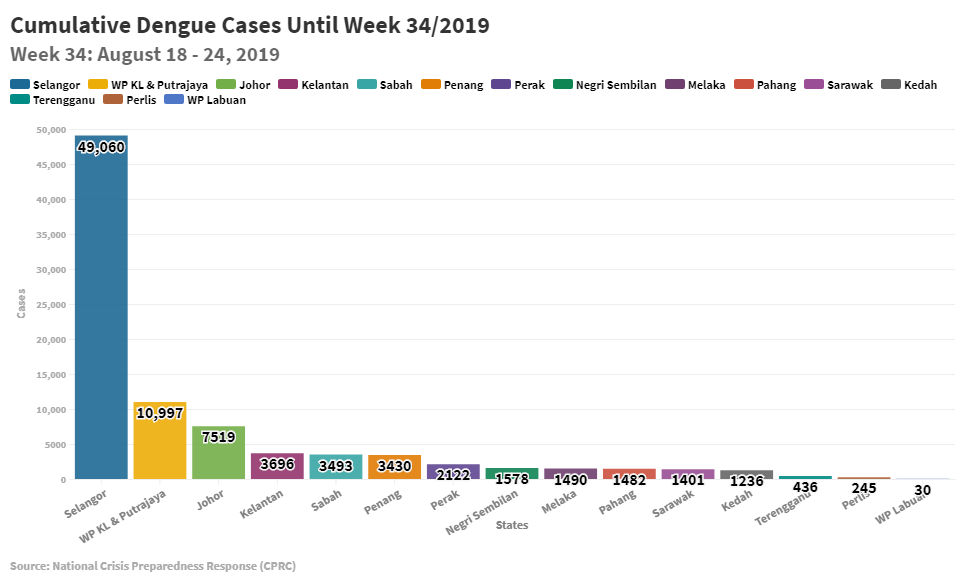KUALA LUMPUR, August 29 — The Health Ministry has issued a “dengue alert” to state directors due to an unusual outbreak nationwide that has killed 125 people so far this year.
According to statistics released by the National Crisis Preparedness Response (CPRC) under the Health Ministry yesterday, 88,215 dengue fever cases were reported in Malaysia from January to August 24, Week 34 of 2019, indicating a whopping 83.3 per cent increase compared to 48,127 cases recorded in the same period in 2018.
A total of 125 people in Malaysia died from dengue fever so far this year up to Week 34, compared to 76 deaths from the mosquito-borne disease in the same period last year.
Health deputy director-general (Public health) Dr Chong Chee Kheong wrote a circular dated last August 21 to all state health department directors throughout Malaysia titled “‘Dengue Alert’: Peningkatan Wabak Luar Biasa Denggi Di Seluruh Negara” (‘Dengue Alert’: The Rise of An Unusual Dengue Outbreak Nationwide). His circular instructed state health departments to prepare plans to handle the unusual dengue fever outbreak, especially in hotspots and localities with the disease.
Dr Chong cited dengue fever statistics up to August 10 in Week 32 of the year, noting a jump of more than 50 per cent in just eight weeks from 1,583 cases in Week 23 to 3,378 cases in Week 32.
“In line with that, YBhg. Datuk/ Dato’ Indera/ Dato’/ Tuan/ Puan is required to take immediate joint action to stop the sudden increase of dengue fever cases and deaths at all levels,” Dr Chong said in a letter sighted by CodeBlue.
He also instructed each hospital to prepare for a rise in dengue fever patients and to even set up a dengue cubicle or ward if necessary.

The states with the highest number of cumulative dengue fever cases up to August 24 in Week 34 of the year were Selangor (49,060 cases), Federal Territories of Kuala Lumpur and Putrajaya (10,997) and Johor (7,519). Other states recorded dengue fever cases of below 4,000, with some only ranging in the hundreds like Perlis (245) and Terengganu (436), or just 30 cases in Labuan.
According to Dr Chong’s letter, public hospitals in Selangor suffered the heaviest dengue fever burden in Malaysia this year with 8,120 cases of non-hemorrhagic dengue fever, namely Hospital Tengku Ampuan Rahimah, Klang (2,298 cases), Sungai Buloh Hospital (1,188), and Kajang Hospital (1,020).
Johor hospitals had the second heaviest dengue fever burden in the country with 2,713 cases of non-hemorrhagic dengue fever, which saw Hospital Sultanah Aminah, Johor Baru, receive 872 cases.
Government hospitals in the Federal Territories of Kuala Lumpur and Putrajaya received the third highest number of non-hemorrhagic dengue fever cases in Malaysia at 2,247 cases, with 1,481 cases in Hospital Kuala Lumpur.
“Dengue contingency plans at the hospital level must be prepared to ensure that the management of patients’ beds and health human resources is optimal during a rise of dengue cases,” Dr Chong wrote.
He also ordered government health clinics and community clinics to ensure that staff were trained in handling dengue fever cases and that frontliners could identify and refer dengue fever cases with warning signs to hospitals.
“Do not prescribe antibiotics to patients diagnosed with dengue because it is a viral infection and can cause warning signs like gastric illness or rashes.”
The Philippines declared a national epidemic earlier this month after a spike in dengue fever killed 622 people, with dengue cases totalling 146,062 up to July 20 this year. Neighbouring Bangladesh is also suffering an outbreak of dengue fever this year, reporting 63,514 cases and 169 deaths, according to a Xinhua report last Sunday.








